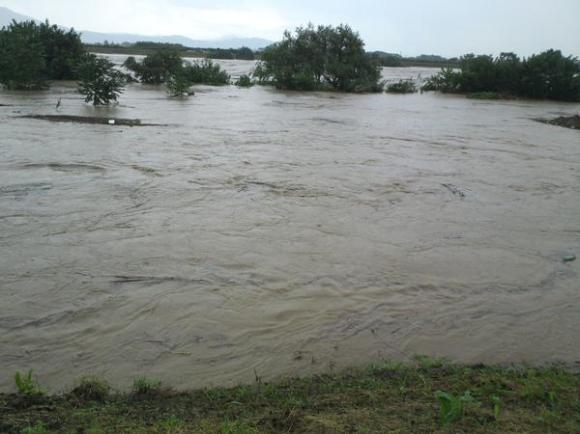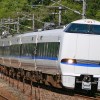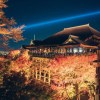
The flooding in Japan has been absolutely awful, without a doubt, and the news has rightly been focused on the resulting devastation. But there is one aspect of the flooding that’s become a bit of a hot topic online, aside from all the rescues and damage. The overflowing river has an…unusual name: Kinu River or the Angry Demon River.
Obviously, the name has proven to be quite apt this year, but it sparked a lot of discussion online as people have wondered: Where the heck did this name come from?!
Of course, when a river has such an evocative name as “the Angry Demon River,” it’s sure to get people’s tongues wagging. And that’s exactly what happened on Twitter, with numerous people discussing the origins (or at least the supposed origins) of the river’s name. There are any number of explanations, but there are two that are particularly common and compelling. The first is that it’s always had the name because its floods were like angry demons and the second is that it was originally called the “Silk River” or the “Cloth River” (the kanji for both “silk” and “cloth” are read “kinu”), but then changed to use the kanji for “angry demon” because of the violent floods.
Here are a few tweets by Japanese Twitter users discussing the river’s name.
爺ちゃん曰く、鬼怒川は昔何度も氾濫してたそうな。
— 🐣MOMO🐣 (@Bashy499) September 10, 2015
鬼が怒ったみたいに氾濫するから、『鬼怒川』らしい。 pic.twitter.com/fWspRyetyC
“According to my grandfather, the Kinu River used to overflow and flood often in the past. Apparently it’s called the ‘Angry Demon’ River because the flooding was like a demon that had gotten angry.”
さっき皆葉で撮ってきた鬼怒川の様子。聞いた話では、昔これ以上の水位になったこともあったとか。 pic.twitter.com/r9DX3cjYfV
— 茶村ニケ (@chamura2k) September 10, 2015
https://twitter.com/masahiko_nis/status/641803061111853058“Here’s a photo of the Kinu River, which everyone has been talking about, right now. Based on what I’ve heard, it used to reach even higher than this a long time ago.”
“The Kinu River is written as the ‘Angry Demon’ River, so it must have been a really scary river since long ago.”
鬼怒川っていつもは本当に静かな川で、昔は「絹川」とか「衣川」って呼ばれました。でも氾濫すると鬼が怒ったように荒れます。 pic.twitter.com/x5GtaIngkr
— rin (@r__nugsaw) September 10, 2015
“The Kinu River is usually a really quiet river, so a long time ago, it used be written with 絹 (kinu), the kanji for silk, or 衣 (kinu), the kanji for cloth. But when it floods, it’s so bad, it’s like an angry demon.”
鬼怒川って、元は”衣川”ってくらいの美しい川なんだが、暴れると酷い災害になるので”鬼が怒る川”ってなったそうなんだよ・・・ま、昔聞いた話なんで、自信ないけど(><;) 茨城に流れた鬼怒川の大水が、酷い事になりませんようにと祈るばかりです
— きつね (@kitune_amekonko) September 9, 2015
“The Kinu River is such a beautiful river that it was originally written with 衣 (kinu), the kanji for cloth, but it causes such awful natural disaster, that it became 鬼怒川 (“Kinugawa”), the Angry Demon River. Well, that’s what I heard a long time ago, but I’m not sure if it’s true. (><;) I’m just praying that the flood from the Kinu River flowing through Ibaraki doesn’t turn into anything too bad.”
▼ Photo of the flooding in Sojo, Ibaraki
スライドショー:茨城県常総市で鬼怒川が決壊http://t.co/xhCrlpws3N pic.twitter.com/UBC1RZZqJ7
— ロイター (@ReutersJapan) September 10, 2015
As you can see, there doesn’t seem to be a lot of agreement or consensus, but you should always take everything you read on the Internet with a grain of salt anyway, right? So, we decided to see if we could find anything like an official explanation for the river’s name. Fortunately, the website for the Shimodate Kasen Office of the The Ministry of Land, Infrastructure, Transport, and Tourism actually has a bit about the river’s name! Let’s see what they have to say.
“There have long been a number of origin stories for the Kinu River’s name. Apparently, long ago, both Ibaraki and Gunma Preferctures were one area called 毛野国 (Kenunokuni), and the river that flowed through it was called 毛野川 (Kenugawa or Kenunogawa), which is today what we call the 鬼怒川 (Kinugawa, or Kinu River). It’s said that in the Ibaraki dialect, the え (“e”) sound is replaced with the い (“i”) sound, and “Kenugawa” got changed to “Kinugawa.” It’s also said that at one point it was written 絹川 (“Kinugawa” or “Silk River”) or 衣川 (“Kinugawa” or “Cloth River”). The reason it is 鬼怒川 (“Kinugawa” or “Angry Demon River”) now is because when it floods, the normally quiet river develops vicious currents and boulders tumble around making loud noises, like a demon getting angry.”
Well, that’s…a little helpful. But at least it’s easier to understand why there’s so much confusion — even the official explanation goes back and forth! But considering the age of many of the place names in Japan are, it’s easy to see how some things could be lost to time.
Of course, the “Angry Demon” River isn’t the only extreme place name in Japan. There’s also 人喰い谷 (“Hitokuidani”) or the Valley the Eats People in Toyama Prefecture, 魔面 (“Maomote”) or the Demon’s Face in Akita Prefecture, 血流れ坂 (“Chinagaresaka”) or the Hill of Flowing Blood in Kanagawa Prefecture, and 地獄谷 (Jigokudani) or Hell Valley in Nagano Prefecture.
Of course, many of these places are also shinrei spots, places believed to be haunted by ghosts. So, if you do decide to take a visit, be sure to bring the Ghostbusters with you!
Sources: Togetter, Ministry of Land, Infrastructure, Transport, and Tourism (Shimodate Kasen Office)
Image: Twitter (@chamura2k)

 Single “Hebel Haus” is the only structure to defy the flooding of Japan’s Angry Demon River
Single “Hebel Haus” is the only structure to defy the flooding of Japan’s Angry Demon River River in Japan’s Nara Prefecture suddenly turns fluorescent green【Videos】
River in Japan’s Nara Prefecture suddenly turns fluorescent green【Videos】 Flood victims send SOS tweets on Twitter in wake of Typhoon Hagibis
Flood victims send SOS tweets on Twitter in wake of Typhoon Hagibis Twitter user caught in Ibaraki flood tweets photos of his rescuers from inside helicopter
Twitter user caught in Ibaraki flood tweets photos of his rescuers from inside helicopter Drones capture shocking footage of flooding in Ibaraki, Japan【Video】
Drones capture shocking footage of flooding in Ibaraki, Japan【Video】 McDonald’s new Happy Meals offer up cute and practical Sanrio lifestyle goods
McDonald’s new Happy Meals offer up cute and practical Sanrio lifestyle goods All-you-can-drink Starbucks and amazing views part of Tokyo’s new 170 meter-high sky lounge
All-you-can-drink Starbucks and amazing views part of Tokyo’s new 170 meter-high sky lounge Studio Ghibli glasses cases let anime characters keep an eye on your spectacles
Studio Ghibli glasses cases let anime characters keep an eye on your spectacles More foreign tourists than ever before in history visited Japan last month
More foreign tourists than ever before in history visited Japan last month Starbucks reopens at Shibuya Scramble Crossing with new look and design concept
Starbucks reopens at Shibuya Scramble Crossing with new look and design concept Beautiful Sailor Moon manhole cover coasters being given out for free by Tokyo tourist center
Beautiful Sailor Moon manhole cover coasters being given out for free by Tokyo tourist center Hey, Japanese taxi driver! Take us to your favorite restaurant in Tsuruga City!
Hey, Japanese taxi driver! Take us to your favorite restaurant in Tsuruga City! All-you-can-eat sashimi from Tokyo’s fish market, convenient location make this budget hotel great
All-you-can-eat sashimi from Tokyo’s fish market, convenient location make this budget hotel great Randomly running into a great sushi lunch like this is one of the best things about eating in Tokyo
Randomly running into a great sushi lunch like this is one of the best things about eating in Tokyo Beautiful, intricate drawings of snowflakes from Edo-era Japan
Beautiful, intricate drawings of snowflakes from Edo-era Japan Disney princesses get official manga makeovers for Manga Princess Cafe opening in Tokyo
Disney princesses get official manga makeovers for Manga Princess Cafe opening in Tokyo Beautiful new Final Fantasy T-shirt collection on the way from Uniqlo【Photos】
Beautiful new Final Fantasy T-shirt collection on the way from Uniqlo【Photos】 Is the new Shinkansen Train Desk ticket worth it?
Is the new Shinkansen Train Desk ticket worth it? Foreign English teachers in Japan pick their favorite Japanese-language phrases【Survey】
Foreign English teachers in Japan pick their favorite Japanese-language phrases【Survey】 Japanese convenience store packs a whole bento into an onigiri rice ball
Japanese convenience store packs a whole bento into an onigiri rice ball We try out “Chan Ramen”, an underground type of ramen popular in the ramen community
We try out “Chan Ramen”, an underground type of ramen popular in the ramen community Studio Ghibli releases Kiki’s Delivery Service chocolate cake pouches in Japan
Studio Ghibli releases Kiki’s Delivery Service chocolate cake pouches in Japan Japan’s bone-breaking and record-breaking roller coaster is permanently shutting down
Japan’s bone-breaking and record-breaking roller coaster is permanently shutting down New definition of “Japanese whiskey” goes into effect to prevent fakes from fooling overseas buyers
New definition of “Japanese whiskey” goes into effect to prevent fakes from fooling overseas buyers Our Japanese reporter visits Costco in the U.S., finds super American and very Japanese things
Our Japanese reporter visits Costco in the U.S., finds super American and very Japanese things Studio Ghibli unveils Mother’s Day gift set that captures the love in My Neighbour Totoro
Studio Ghibli unveils Mother’s Day gift set that captures the love in My Neighbour Totoro Foreign passenger shoves conductor on one of the last full runs for Japan’s Thunderbird train
Foreign passenger shoves conductor on one of the last full runs for Japan’s Thunderbird train Domino’s Japan now sells…pizza ears?
Domino’s Japan now sells…pizza ears? New Japanese KitKat flavour stars Sanrio characters, including Hello Kitty
New Japanese KitKat flavour stars Sanrio characters, including Hello Kitty Kyoto creates new for-tourist buses to address overtourism with higher prices, faster rides
Kyoto creates new for-tourist buses to address overtourism with higher prices, faster rides Sales of Japan’s most convenient train ticket/shopping payment cards suspended indefinitely
Sales of Japan’s most convenient train ticket/shopping payment cards suspended indefinitely Sold-out Studio Ghibli desktop humidifiers are back so Totoro can help you through the dry season
Sold-out Studio Ghibli desktop humidifiers are back so Totoro can help you through the dry season Japanese government to make first change to romanization spelling rules since the 1950s
Japanese government to make first change to romanization spelling rules since the 1950s Ghibli founders Toshio Suzuki and Hayao Miyazaki contribute to Japanese whisky Totoro label design
Ghibli founders Toshio Suzuki and Hayao Miyazaki contribute to Japanese whisky Totoro label design Doraemon found buried at sea as scene from 1993 anime becomes real life【Photos】
Doraemon found buried at sea as scene from 1993 anime becomes real life【Photos】 Tokyo’s most famous Starbucks is closed
Tokyo’s most famous Starbucks is closed One Piece characters’ nationalities revealed, but fans have mixed opinions
One Piece characters’ nationalities revealed, but fans have mixed opinions We asked a Uniqlo employee what four things we should buy and their suggestions didn’t disappoint
We asked a Uniqlo employee what four things we should buy and their suggestions didn’t disappoint Princesses, fruits, and blacksmiths: Study reveals the 30 most unusual family names in Japan
Princesses, fruits, and blacksmiths: Study reveals the 30 most unusual family names in Japan Mystery of flesh-melting road in Kawasaki solved
Mystery of flesh-melting road in Kawasaki solved Photographer captures gorgeous shots of Kyoto’s Kamogawa River
Photographer captures gorgeous shots of Kyoto’s Kamogawa River “Kind Chinese” vs “Greedy Chinese”: Efforts to save wild carp instantly nullified
“Kind Chinese” vs “Greedy Chinese”: Efforts to save wild carp instantly nullified Yes, believe your eyes: That is indeed a five-story building floating down a Chinese river
Yes, believe your eyes: That is indeed a five-story building floating down a Chinese river 18 awesome overnight hot spring trips from Tokyo, and a quiz to help pick the best one for you
18 awesome overnight hot spring trips from Tokyo, and a quiz to help pick the best one for you Skip the crowds at Tokyo’s most popular cherry blossom spot with Meguro River Hanami Cruise
Skip the crowds at Tokyo’s most popular cherry blossom spot with Meguro River Hanami Cruise We visited Japan’s number one udon store in Gunma Prefecture
We visited Japan’s number one udon store in Gunma Prefecture That moment when Google Maps tells you there’s a crab claw somewhere…and there actually is!
That moment when Google Maps tells you there’s a crab claw somewhere…and there actually is! Renowned Japanese calligraphy teacher ranks the top 10 kanji that foreigners like
Renowned Japanese calligraphy teacher ranks the top 10 kanji that foreigners like Couldn’t catch the cherry blossoms in full bloom? We’ve got a unique idea for you!
Couldn’t catch the cherry blossoms in full bloom? We’ve got a unique idea for you! 17 new designs unveiled in round two of regional Japanese license plates
17 new designs unveiled in round two of regional Japanese license plates Japan has an awesome river that looks just like a dragon
Japan has an awesome river that looks just like a dragon Japanese government plans removal of around 2,485 miles’ worth of overhead power lines
Japanese government plans removal of around 2,485 miles’ worth of overhead power lines We caught the Angry Birds limited-time menu at McDonald’s Singapore!
We caught the Angry Birds limited-time menu at McDonald’s Singapore! When the pandemic is over…Beautiful photos of places Japan travelers want to visit after corona
When the pandemic is over…Beautiful photos of places Japan travelers want to visit after corona
Leave a Reply